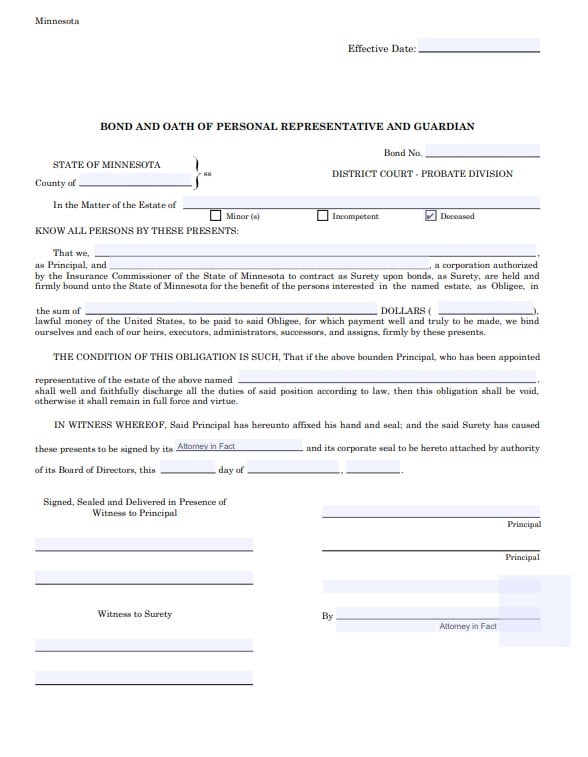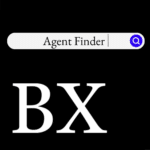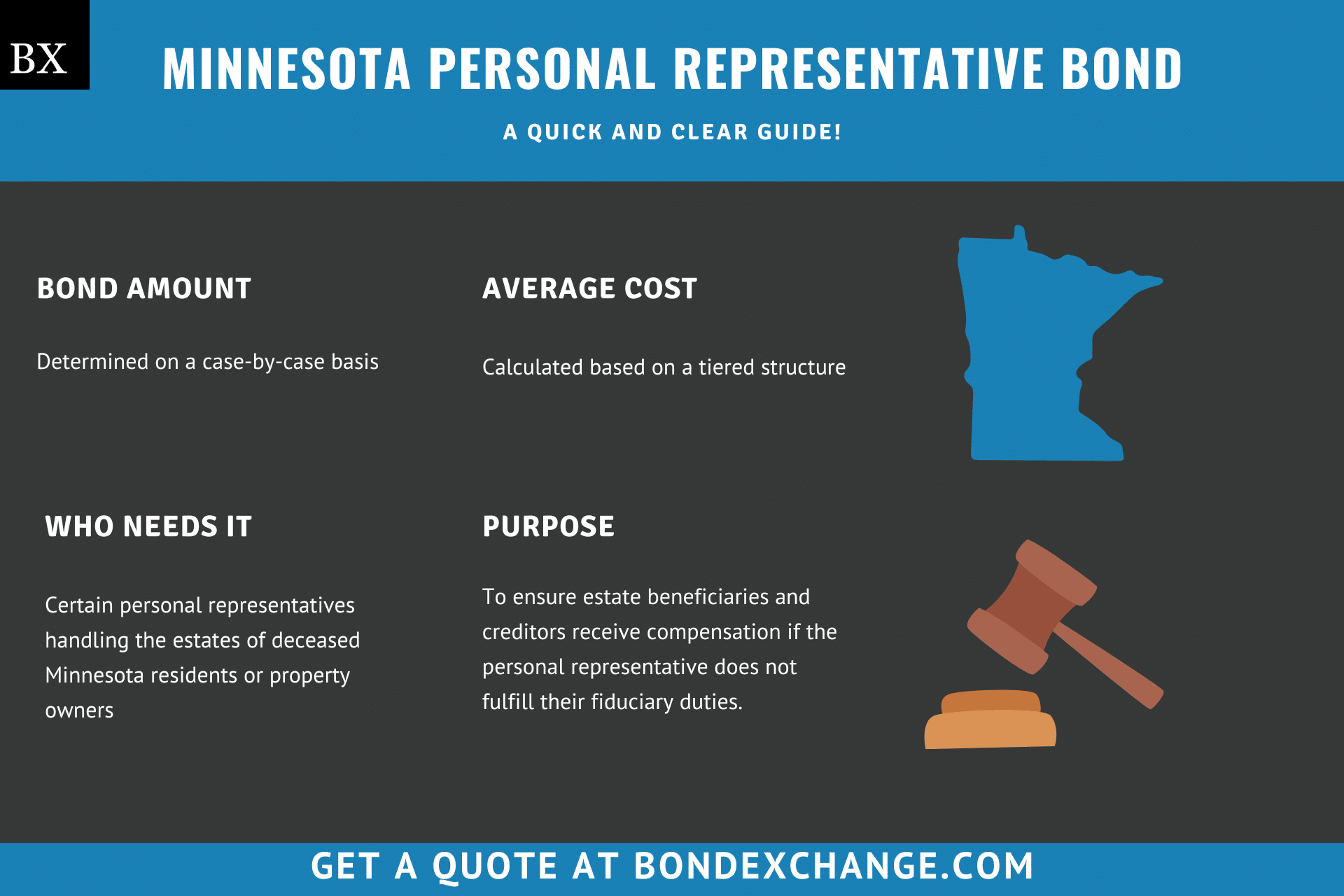Minnesota Personal Representative Bond: A Comprehensive Guide
This guide provides information for insurance agents to help their customers obtain a Minnesota Personal Representative bond.
At a Glance:
- Average Cost: Calculated based on a tiered structure
- Bond Amount: Determined on a case-by-case basis (more on this later)
- Who Needs it: Certain personal representatives handling the estates of deceased Minnesota residents or property owners
- Purpose: To ensure estate beneficiaries and creditors receive compensation if the personal representative fails to fulfill their fiduciary duties
- Who Regulates Personal Representatives in Minnesota: The local court of the county where the deceased individual resided or had property

Background
Minnesota Statute 524.3-103 requires all personal representatives of an estate to be appointed by a court before assuming their fiduciary duties. The Minnesota legislature enacted the appointment requirement to ensure that personal representatives do not mismanage the estate’s assets. To provide financial security for the enforcement of this requirement, the court may require the personal representative to purchase a probate surety bond to be eligible for appointment.
What is the Purpose of the Minnesota Personal Representative Bond?
Minnesota requires personal representatives to purchase a surety bond as a prerequisite to being appointed as a fiduciary over an estate’s assets. The bond ensures that the estate’s beneficiaries and creditors will receive compensation for financial harm if the personal representative fails to abide by the regulations outlined in Minnesota Statute 524.3-606. Specifically, the bond protects beneficiaries and creditors if the personal representative engages in fraud or fails to properly distribute the estate’s assets. In short, the bond is a type of insurance that protects the estate’s beneficiaries and creditors if the personal representative violates their fiduciary duties.
How Can an Insurance Agent Obtain a Minnesota Personal Representative Surety Bond?
BondExchange makes obtaining a Minnesota Personal Representative bond easy. Simply login to your account and use our keyword search to find the “Probate” bond in our database. Don’t have a login? Gain access now and let us help you satisfy your customers’ needs. Our friendly underwriting staff is available by phone (800) 438-1162, email or chat from 7:30 AM to 7:00 PM EST to assist you.
At BondExchange, our 40 years of experience, leading technology, and access to markets ensures that we have the knowledge and resources to provide your clients with fast and friendly service whether obtaining quotes or issuing bonds.
Not an agent? Then let us pair you with one!

Click the above image to find a BX Agent near you
How is the Bond Amount Determined?
Minnesota Statute 524.3-604 grants the court the authority to determine the required bond amount on a case-by-case basis. When determining the required amount, the court will consider factors such as the value of the estate and the income it is expected to generate during the administration period. The bond amount may be reduced by the value of the estate’s assets deposited with a domestic financial institution in a manner that prevents their unauthorized disposition. Any interested person, including the personal representative, may petition the court to increase or reduce the required bond amount.
What are the Underwriting Requirements for the Minnesota Personal Representative Bond?
Most surety companies will examine the following factors when determining eligibility for the Minnesota Personal Representative bond:
- Personal representative’s credit history (not considered for bonds with limits less than $25,000)
- Whether or not the estate has an attorney (not considered for bonds with limits less than $25,000)
- How long the fiduciary appointment is for
- Whether or not the personal representative is replacing a prior fiduciary
- If the personal representative has ever committed a felony
- If there are disputes among the estate’s beneficiaries
- Whether or not there is any ongoing business in the estate
- If the bond is being required by a creditor
How Much Does the Minnesota Personal Representative Bond Cost?
Surety companies typically determine the premium rate for personal representative bonds based on a tiered structure. As a result, larger bond amounts will be charged a lower premium rate than smaller bonds.
The following table illustrates the pricing structure for the Minnesota Personal Representative bond:
$1,500,000 Personal Representative Bond Cost
| Bond Amount | Premium Rate | Total Bond Cost |
|---|---|---|
| First $20,000 | 0.75% | $150 |
| Next $40,000 | 0.60% | $240 |
| Next $140,000 | 0.50% | $700 |
| Next $300,000 | 0.375% | $1,125 |
| Next $1,000,000 | 0.25% | $2,500 |
| Total cost of $4,715 |
Who is Required to Purchase the Minnesota Personal Representative Bond?
Personal representatives in Minnesota may be required to purchase a bond at any point during formal testacy. Typically, courts will require a bond if one is deemed necessary to protect the interests of the estate’s beneficiaries and creditors. Personal representatives will not be required to purchase a bond during formal testacy if the will waives the bond requirement or if all persons with an interest of at least $1,000 in the estate (excluding creditors) agree to waive the bond requirement. However, the court may at any time require an exempt personal representative to purchase a bond if they determine that one is necessary.
Personal representatives are not required to purchase a bond during informal probate, except in the following situations:
- They are a special administrator
- The will explicitly requires one
- If any person with an interest of at least $1,000 in the estate petitions the court to require one and their petition is determined to have merit
To paraphrase Minnesota Statute 241.1-201, a personal representative is a court-appointed fiduciary responsible for administering a deceased individual’s estate. Personal representatives are referred to as executors if the deceased individual nominated them in their will (testate), and administrators if they were not nominated if no will exists (intestate). Additionally, a special personal representative is someone temporarily appointed to administer the estate while a general personal representative is in the process of being appointed.

How do Personal Representatives Become Appointed in Minnesota?
Personal representatives in Minnesota must navigate several steps to become court-appointed fiduciaries. Below are the general guidelines, but applicants should refer to Minnesota’s uniform probate code and the state’s Department of Human Services website for details on the process.
Step 1 – Meet the Qualifications
Personal representatives are ineligible for appointment if they are:
-
- Under the age of 18
- Deemed unsuitable by the court
Step 2 – Determine Priority
Priority for appointment as a personal representative is granted in the following order:
-
- Persons nominated in the will or any person(s) they nominate (if nominating power is granted in the will)
- The surviving spouse, provided they are a devisee (entitled to real property) of the estate
- Any other devisee
- Any other heir
- Any creditor, provided the deceased individual has been dead for at least 45 days
- Any conservator of the deceased individual that has not been discharged, provided the deceased individual has been dead for at least 90 days
Any person with priority may nominate another qualified person to serve in their place. If an objection to the appointment of a specific personal representative is made in formal testacy, then the order of priority outlined above still stands, except in the following situations:
-
- The court may appoint any qualified person if the estate seems capable of meeting exemptions and costs of administration but incapable of discharging unsecured claims and any creditor petitions them to do so
- If any estate beneficiary objects to an appointment (other than for a person nominated in the will) the court may appoint a person that is acceptable to all devisees and is entitled to more than half the distributable value of the estate, or in the absence of such a person, any qualified person.
When two or more people share priority, they must agree on who will be appointed.
Step 3 – Hire an Attorney
Although not explicitly required, it is highly recommended that personal representatives hire an attorney to assist with the probate process.
Step 4 – Determine the Estate Administration Type
Minnesota has three distinct estate administration types, as outlined below:
-
- Informal Probate: The personal representative can administer the estate with minimal court supervision.
- Formal Testacy: Traditional court proceedings to determine how to settle the estate and/or the appointment of a personal representative. Formal testacy begins when an interested person petitions the court to initiate it.
- Small Estate: A much simpler process where property may be distributed via an affidavit. Small estate administration is only available to estates:
- That are less worth than $75,000
- Where the deceased individual has been dead for at least 30 days
- Where there is no pending application for the appointment of a personal representative
Step 5 – Contact the Court
Personal representatives must contact the local court of the county with jurisdiction over the deceased individual’s estate. A representative of the court will walk the personal representative through the appointment process, provide them with all required forms, and answer any questions they may have.
Step 6 – Purchase a Surety Bond
Unless otherwise exempt, personal representatives must purchase and maintain a surety bond (limits outlined above).
How do Minnesota Personal Representatives File Their Bonds?
Personal representatives should submit their completed bond forms, including the power of attorney, to the local court of the county with jurisdiction over the estate.
The surety bond requires signatures from the company that issues the bond and the personal representative. The surety company should include the following information on the bond form:
- County where the bond will be filed
- Legal name of the entity/individual(s) buying the bond
- Name of the deceased individual
- Surety company’s name
- Bond amount
- Date the bond is signed
What can Minnesota Personal Representatives do to Avoid Claims Made Against Their Bonds?
To avoid claims against their bonds, personal representatives in Minnesota must ensure that they:
- Do not engage in any acts of fraud
- Do not mismanage the estate’s assets
- Fulfill their fiduciary duties
